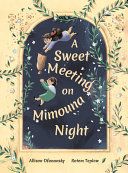A Sweet Meeting on Mimouna Night
 A Sweet Meeting on Mimouna Night
A Sweet Meeting on Mimouna Night
Picture Book
Groundwood Books
October 6, 2020
36

A story about a young girl celebrating the Moroccan Jewish holiday of Mimouna with a new Muslim friend.
A Sweet Meeting on Mimouna Night by Allison Ofanansky uses the Moroccan Jewish holiday of Mimouna to disseminate values of peaceful co-existence and tolerance between Jews and Muslims. Mimouna commemorates Passover when Jews fleeing Egypt had no time to let bread dough rise. In the days before Passover, Moroccan Jews clear their houses of flour and leavening ingredients. Families wait in great anticipation for Mimouna Night when moufletot, sweet paper-thin pancakes, can be made and consumed again. Many rely on their Muslim neighbors to bring them flour when dietary restrictions are lifted and baking can begin.
The setting for this Mimouna story is the great city of Fes (Fez), Morocco where Jews and Muslims lived in peace (with occasional conflicts) from the 6th century until 1948. With the founding of the state of Israel, most members of the 40,000-strong Jewish community left Morocco for Israel. Only about 2,000 Jewish Moroccans live in Morocco today. The observance of Mimouna continues, particularly in Israel where it is widely celebrated.
The central characters in A Sweet Meeting on Mimouna Night are two little girls — one Jewish, one Muslim — who share the innocent joy of celebrating Mimouna. Mariam, the young Jewish girl, innocently asks her mother where they can get flour to make moufletot. Instead of answering, Mother leads Mariam into the starry night, past a synagogue, to a part of the city that is unfamiliar to Mariam. Mother stops at a gate and lovingly greets a Muslim woman who comes into the courtyard. The woman is accompanied by her daughter Jasmine, a girl Miriam’s age. After sharing tea, Jasmine’s mother gives Mariam’s mother a sack of flour. Mother explains to a questioning Mariam, “I go there every year to get flour for Mimouna.” Later Jasmine and her mother visit Mariam’s family to celebrate Mimouna Night. At the end of the evening, Jasmine notes the similarities between Mimouna Night and “our Ramadan holiday….We fast every day and have big meals at night.” The illustrations amplify the story’s message of tolerance, showing images of mosques alongside synagogues. The end notes describe Mimouna and provide a recipe for making moufletot.
One wishes the author had balanced information on Mimouna with more details about Ramadan, including the daily iftar (meal) during the holy month of Ramadan, and more about Eid ul Fitr, the big feast held in celebration of the end of Ramadan. More importantly, although the story is a stellar example of religious diversity and inclusivity in Morocco, the final pages of the book undercut the book’s message of tolerance and coexistence. The story ends with the departure of Miriam’s family to Jerusalem. No explanation for this abrupt departure is provided. Targeted at children with no religious biases, the author should have been apolitical, avoiding the statement “Next Year in Jerusalem.’‘ After all, Jerusalem is equally special to Jews, Christians, and Muslims around the world. This narrows down the story’s audience to those in strong support of Israel as the final destination of every Arab Jew and discards the indigeneity of Jews to Morocco among other Arab countries.
Reviewed by Naglaa Mahmoud Hussein, Ph.D. George Mason University
Published in Africa Access Review (October 28, 2021)

Thank you for posting my book on your site!